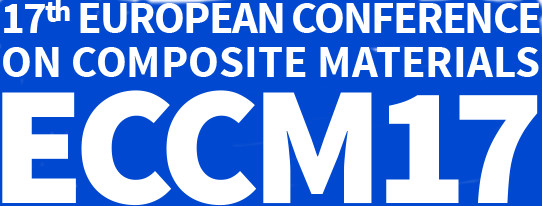

App-Einstellungen:
FULLY REVERSED MODE II FATIGUE TESTING
Rico Kühlewind (University of Bristol) Luiz Kawashita (University of Bristol) Stephen Hallett (University of Bristol)
For a better understanding of composite fatigue, work on fully reversed mode II delamination growth was conducted. A test method was introduced. Test results are presented and compared to non reversed fatigue cases. Future challenges are identified.
IN-SITU FATIGUE DAMAGE ASSESSMENT OF CARBON FIBRE REINFORCED POLYMER STRUCTURES USING ADVANCED EXPERIMENTAL TECHNIQUES
Nikolaos Eleftheroglou (Delft University of Technology) D. S. Zarouchas (Delft University of Technology) Theodoros Loutas (University of Patras)
This study focused on the in-situ fatigue damage assessment of open-hole carbon/epoxy coupons using Acoustic Emission (AE) and Digital Image Correlation (DIC) techniques.
INFLUENCE OF MICRO-VOIDS ON THE FATIGUE BEHAVIOUR OF GLASS/EPOXY LAMINATES
Lucio Maragoni (University of Padova) Paolo Andrea Carraro (University of Padova) Marino Quaresimin (University of Padova)
The influence of micro-sized voids on fatigue damage evolution is investigated on [0/90]S and [0/45/0/-45]S laminates, highlighting a large detrimental effect on both stacking sequences even for small void contents.
INVESTIGATION OF COMPOSITES VIBRATION FATIGUE BEHAVIOUR: HIGH FREQUENCY MODE II DELAMINATION PROPAGATION
Guillaume Androuin (Institut Supériaur de l'Aéronautique et de l'Espace, ISAE) Laurent Michel (Institut Supériaur de l'Aéronautique et de l'Espace, ISAE) Xiaojing Gong (Institut Supériaur de l'Aéronautique et de l'Espace, ISAE) Irène Maillet (DGA-TA)
Mode II crack propagation tests were conducted at high frequency (>200Hz). Low frequency crack propagation tests were conducted at different load ratios. Results in terms of Fatigue Crack Growth Rate vs Energy Release Rate curves are compared.
INVESTIGATION OF THE EFFECT OF WATER JET CUTTING AND MACHINING ON CRACK INITIATION IN OFF-AXIS TEST SPECIMENS
Jens Jakob Bender (Aalborg University) Jens Ammitzbøll Glud (Aalborg University) Esben Lindgaard (Aalborg University)
The paper describes preliminary fatigue results from off-axis specimen tests. The transmitted light technique is used, but several complications with high contrast gradients are encountered and attempted solved using negative images on transparencies.
MODELLING THE DEGRADATION OF Z-PINS UNDER CYCLIC LOADING CONDITIONS
Felix Warzok (University of Bristol) Giuliano Allegri (Imperial College London) Maik Gude (Technical University of Dresden) Stephen Hallett (University of Bristol)
The findings from a previous micro mechanical study characterising the behaviour of Z-pins under various fatigue loading conditions are transferred into an analytical/numerical model and validated with bespoke meso scale DCB and ELS tests.
A COMPARISON OF QUASI-STATIC INDENTATION AND LOW VELOCITY IMPACT ON HYBRID COMPOSITE-METALLIC STRUCTURES USING MICRO-FOCUS COMPUTED TOMOGRPAHY
Trevor Allen (University of Southampton) Sharif Ahmed (University of Southampton) Philippa Reed (University of Southampton) Ian Sinclair (University of Southampton) Mark Spearing (University of Southampton)
The equivalence of quasi-static indentation and low velocity impact loading regimes has been assessed in hybrid composite-metallic structures. The results demonstrate a strong equivalence between QSI and LVI loading regimes in these structures.
A NUMERICAL-EXPERIMENTAL STUDY OF THE DAMAGE RESPONSE OF STITCHED COMPOSITE LAMINATES TO LOW VELOCITY IMPACT
Luca Francesconi (University of Cagliari) Francesco Ginesu (University of Cagliari) Francesco Aymerich (University of Cagliari)
The study examines experimentally and by FE analises the effect of stitching on the impact behaviour of cross-ply carbon/epoxy laminates. The developed model is able to capture the role of stitching in enhancing the impact damage resistance of the laminates.
AN INVESTIGATION ON THE INFLUENCE OF LOADING RATE ON THE FRACTURE TOUGHNESS OF UHMW-PE COMPOSITES
Michael May (Fraunhofer EMI) Torsten Lässig (Fraunhofer EMI) Stefan Hiermaier (Fraunhofer EMI)
A material model for cohesive interface elements is proposed which allows describing the rate-dependent evolution of strength and fracture toughness of Dyneema HB26 composites. The model is verified against DCB tests at high rates of loading.
LOW-VELOCITY IMPACT BEHAVIOR MODELLING OF BRAIDED TEXTILE COMPOSITES FOR SPORTS PROTECTION
Chen Wang (Nanyang Technological University) Anish Roy (Loughborough University) Zhong Chen (Nanyang Technological University) Vadim Silberschmidt (Loughborough University)
A multi-scale computational approach is explored to predict low-velocity impact performance of braided textile composites under impact conditions with energy levels between 3 J to 9 J; the obtained results are compared with original experiments.
